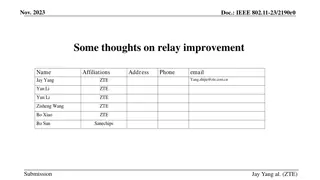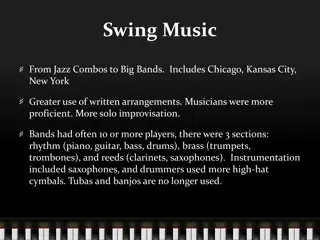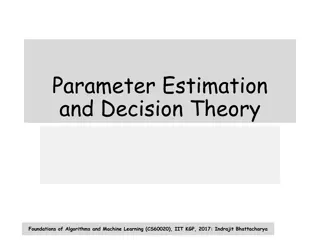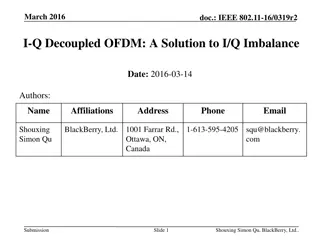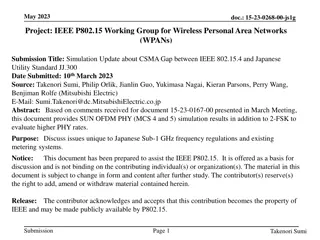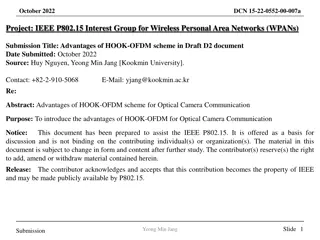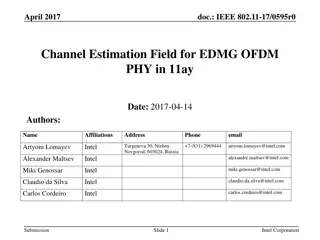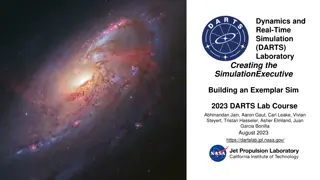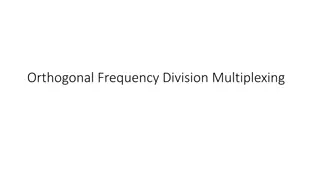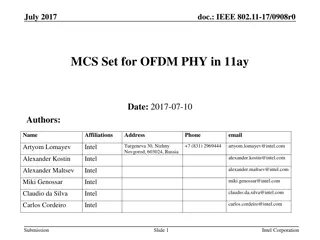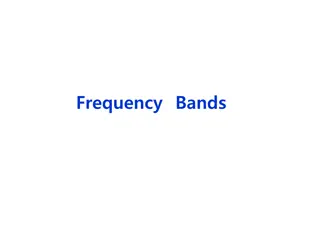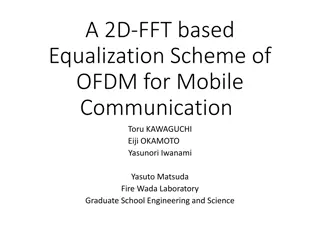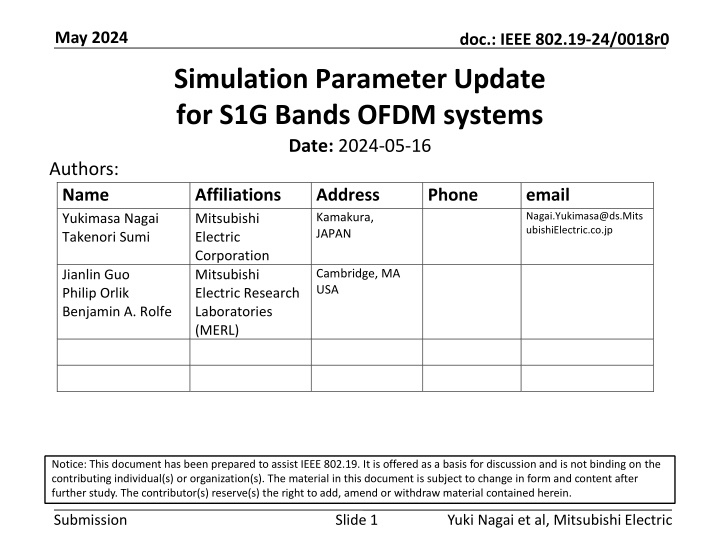
IEEE 802.19-24 Simulation Parameters Update for S1G Bands OFDM Systems
Explore the latest simulation parameters update for S1G Bands OFDM systems in May 2024 document IEEE 802.19-24/0018r0. Compare simulation results based on IEEE 802.15.4g FSK PHY and IEEE 802.11ah channels through detailed summaries and analysis.
Uploaded on | 0 Views
Download Presentation

Please find below an Image/Link to download the presentation.
The content on the website is provided AS IS for your information and personal use only. It may not be sold, licensed, or shared on other websites without obtaining consent from the author. If you encounter any issues during the download, it is possible that the publisher has removed the file from their server.
You are allowed to download the files provided on this website for personal or commercial use, subject to the condition that they are used lawfully. All files are the property of their respective owners.
The content on the website is provided AS IS for your information and personal use only. It may not be sold, licensed, or shared on other websites without obtaining consent from the author.
E N D
Presentation Transcript
May 2024 doc.: IEEE 802.19-24/0018r0 Simulation Parameter Update for S1G Bands OFDM systems Date: 2024-05-16 Authors: Name Yukimasa Nagai Takenori Sumi Jianlin Guo Philip Orlik Benjamin A. Rolfe Affiliations Mitsubishi Electric Corporation Mitsubishi Electric Research Laboratories (MERL) Address Kamakura, JAPAN Phone email Nagai.Yukimasa@ds.Mits ubishiElectric.co.jp Cambridge, MA USA Notice: This document has been prepared to assist IEEE 802.19. It is offered as a basis for discussion and is not binding on the contributing individual(s) or organization(s). The material in this document is subject to change in form and content after further study. The contributor(s) reserve(s) the right to add, amend or withdraw material contained herein. Submission Slide 1 Yuki Nagai et al, Mitsubishi Electric
May 2024 doc.: IEEE 802.19-24/0018r0 Summary Simulation parameters for S1G Bands OFDM systems evaluation to compare IEEE 802.19.3 simulation results based on IEEE 802.15.4g FSK PHY and IEEE 802.11ah 1MHz channel (doc.: IEEE 802.19-19/0019) with IEEE 802.19.3a simulations based on IEEE 802.15.4g OFDM PHY and IEEE 802.11ah 4MHz channel. New simulation parameters considers smart utility use cases of coexistence IEEE 802.15.4g-OFDM PHY and IEEE 802.11ah (4MHz BW) This document gathers relevant material from 19-19/0019r1, 19-18/0056r3, 19-18/0039r1 and 19-19/0021r2. Submission Slide 2 Yuki Nagai et al, Mitsubishi Electric
May 2024 doc.: IEEE 802.19-24/0018r0 Background: S1G Coexistence Simulations in TG3 Developed the coexistence simulator based on NS-3.23, which support IEEE 802.15.4g-FSK (400 KHz bandwidth) and IEEE 802.11ah (1 MHz bandwidth) for IEEE 802.19.3. Simulation parameters and simulator deployment were discussed in TG3, and simulation results were also shared. o 19-19/0019r1, 19-18/0056r3, 19-18/0039r1 and 19-19/0019r2 Simulation Model by NS-3 Submission Slide 3 Yuki Nagai et al, Mitsubishi Electric
May 2024 doc.: IEEE 802.19-24/0018r0 Simulation Parameters and Performance Metrics Sub-1 GHz Coexistence Simulation Parameters have been specified in doc. 19-18/0039. Some simulation parameters were updated based on the March 2024 meeting. Number of nodes o [15*, 50, 100] *500 nodes / km2 based on use case comments at IEEE 802.19.3, March 2019. Total offered load for 802.15.4g-OFDM PHY network and 802.11ah network o [20 120] kb/s for IEEE 802.11ah (1 MHz BW) o [80 480] kb/s for IEEE 802.11ah (4 MHz BW) o [10, 20, 40] kb/s for IEEE 802.15.4g-FSK PHY o [20 100] kb/s for IEEE 802.15.4g-OFDM PHY Packet size o 100 byte PHY data rate o BPSK , Nss = 1, 300 kb/s for 802.11ah (1 MHz BW) o 2FSK, 100 kb/s for 802.15.4g-FSK PHY o OFDM Option 3 MCS4, 300 kb/s, and OFDM Option 3 MCS 5, 400kb/s for IEEE 802.15.4g-OFDM PHY Data packet delivery rate o # ?? ??????? ??????????? Data packet latency o Start timer when CSMA/CA is started, stop timer when ACK is received. o ????????+ ???????+ ????????+ ?????? Propagation Model o SEAMCAT Extended Hata Model (Suburban) based on use case comments at IEEE 802.19.3, March 2019. 802.15.4: Utility pole height to node location level 802.11ah: AP/STA location level o ITU-R P.1411 NLoS (between terminals located from below roof-top height to near street level) # ?? ??????? ???????? Submission Slide 4 Yuki Nagai et al, Mitsubishi Electric
May 2024 doc.: IEEE 802.19-24/0018r0 Node Deployment : 15 nodes (500 nodes/km2)* 100 802.11ah (AP/STA) #1 80 802.11ah (AP/STA) #2 60 802.11ah (AP/STA) #3 40 802.15.4g (PANC) 802.15.4g (NODE) * 20 y[m] 0 -20 -40 -60 -80 -100 -100 -80 -60 -40 -20 0 20 40 60 80 100 x[m] Submission Slide 5 Yuki Nagai et al, Mitsubishi Electric *Same condition discussed in TG3
May 2024 doc.: IEEE 802.19-24/0018r0 Propagation Model* In consideration of device location, SEAMCAT Extended Hata Model (Suburban) was also added for simulation. Device location o 802.15.4: Utility pole height to node location level o 802.11ah: AP/STA location level SEAMCAT Extended Hata Model ITU-R P.1411 Models for propagation between terminals located from below roof-top height to near street level Submission Slide 6 Yuki Nagai et al, Mitsubishi Electric *Same condition discussed in TG3
May 2024 doc.: IEEE 802.19-24/0018r0 Propagation Model* SEAMCAT Extended Hata Model (Suburban) 802.15.4g Submission Slide 7 Yuki Nagai et al, Mitsubishi Electric *Same condition discussed in TG3
May 2024 doc.: IEEE 802.19-24/0018r0 Simulation Matrix for TG3 and TG3a 4 types of PHY combination are possible. Starting implementation in the following order to show simulation results in July or September meeting. IEEE 802.11ah (1 MHz) (TG3) IEEE 802.11ah (4 MHz) IEEE 802.15.4g-FSK PHY (2) IEEE 802.15.4g-OFDM PHY (1) (3) Submission Slide 8 Yuki Nagai et al, Mitsubishi Electric
March 2019 doc.: IEEE 802.19-24/0018r0 Summary Updated simulation parameters for coexistence evaluation between IEEE 802.15.4g-OFDM PHY and IEEE 802.11ah (4 MHz bandwidth) in consideration with past simulation parameters discussed in IEEE 802.19.3. After feedbacks for simulation parameters, we would like to perform network simulation using the developed NS-3 simulator. Submission Slide 9 Yuki Nagai et al, Mitsubishi Electric

